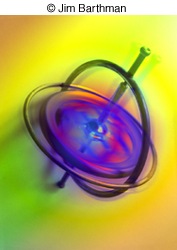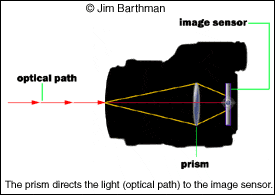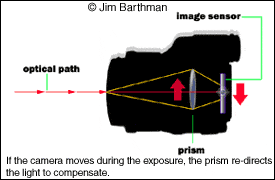
Would you like to know the secret to making the sharpest photographs possible? Remember it's a secret so don't spread it around. Okay, here it is. Use a tripod. That's right, if you want to make the best pictures you can possibly make, you'll need the support of a good, reliable tripod. Sure it slows you down, it's clumsy, heavy, and generally bothersome...but without it, we all risk the possibility of taking an unsharp photo due to camera shake.
The truth is, in most situations, we just can't be bothered with a tripod; so it stays at home. We all know that's bad. Camera manufacturers know it too. As a result, several major camera makers have taken steps to combat the problem of "camera shake".
Using very small gyroscopic sensors, image stabilization systems can now provide the stability needed to take sharp accurate photographs under less than perfect conditions.

Actually, IS (Image Stabilization) technology is based on a concept that professional photographers and filmmakers have relied on for years, the gyroscope. Gyroscopic stabilizers are often mounted to a camera to "dampen" or reduce camera movement. These stabilizers use two spinning disks set perpendicularly to each other which in effect steadies the movement of the camera that is attached. A gyroscopic stabilizer gives a photographer better odds of getting a sharp shot from a shaky helicopter or fast-moving car. But old school gyroscopes are big, bulky, and expensive pieces of equipment.
Through the miracle of miniaturization today's image stabilization systems can fit inside the camera itself! Let's not get ahead of ourselves. We first need to start by explaining what camera shake is.
What is Camera Shake?

Camera shake is the small amount of movement a camera makes when you press the shutter. That's right, the seemingly insignificant act of pressing the shutter release while hand holding a camera can cause image blur. Sure it may seem insignificant, but if your goal is to produce high-quality photography, a stable camera is a necessity.
How does Image Stabilization help?
As with most digital technology, different manufacturers are taking on the problem slightly differently. Although IS does come in many different forms, the common denominator is the gyroscopic sensor and its ability to stabilize the optical path instead of the entire camera.
Minolta's Prism Adjustment.

In a nutshell, here's how on-camera image stabilization works. If the camera moves during exposure, the camera recognizes the movement, and moves a prism between the lens and the CCD to re-direct the light path to compensate for the unintended movement.
The camera moves one way, and the prism moves the other. Konica Minolta pioneered this on-camera system in several point-and-shoot models as well as the digital Maxxum 7D SLR camera. Other manufacturers are following Konica Minolta's lead.
For everything to work correctly the sensors must be able to accurately detect camera movement in two directions. One sensor is designed to detect "pitching" vertical movement. The other sensor detects "yawing" or horizontal movement. Once the light rays are stabilized the exposure can be made, producing a sharp photo free of blurs.
Image Stabilization in Lens Elements.
Nikon is using similar technology to compensate for unintentional camera movement. Instead of a prism in the camera, Nikon's VR (Vibration Reduction) lenses use sensors to move a lens element within the barrel of the lens. Although the net effect is exactly the same, because the mechanism is inside the lens, it can be used by both digital and film enthusiasts alike, but each lens that has this feature costs more than it would without it. In addition to Nikon's VR lenses, there are Canon IS lenses and Sigma OS (Optical Stabilizer) models.
Speed and Accuracy.
Considering the speed of today's modern auto-exposure cameras coupled with super-fast auto-focus lenses, image stabilization is a remarkable feat indeed. We're talking about very small, very precise movements, which need to happen in an instant. The thought of enduring shutter lag is no longer an option for digital photographers. We simply won't stand for it any longer. It seems camera manufacturers have obliged. The speed of these things is actually mind-numbing.
Using an image stabilization system essentially makes your camera/lens 3-stops faster. That can mean the difference between success and failure. It also means that you'll be able to use that 10x optical zoom and get back sharp focused pictures without the need for a tripod or monopod.
Let's discuss when you might need the assistance of an image stabilization system.
Low-light Situations.
Here's the scenario, the light is fading fast, you've opened your lens up to its widest aperture and now your shutter speed is reaching the point where hand holding just isn't an option anymore. 1/60 of a second is generally accepted as the slowest shutter speed you should use if you are shooting "hand-held". So anything below that, you are going to get blurry photos. Using IS you'll be able to shoot with slower shutter speeds and still get the sharpness you crave.

Panning.
The art of synchronizing the movement of the camera with the movement of the subject is known as panning. A good pan results in a blurred background and a sharp subject. Again the success of this technique relies on the ability to choose an appropriate shutter/aperture combination.
Macro Mode.
Shooting extreme close up images magnifies movement and, as such, will require faster shutter speeds, wider apertures or stabilization in one way or another. The more versatility you have in terms of exposure the better your chances at success.
Telephoto Mode.
Lastly, we have telephoto mode. Similarly to Macro, movement is magnified at the lens extremes. The longer the focal length, the faster shutter speed should be if you want to get sharp photos. The long established rule for 35mm photography states that in order to produce sharp hand-held photos, the shutter speed denominator value should be, at least, equal to the focal length. So for example, if you are shooting with a 200mm lens, the shutter speed should be set to 1/200 or faster.
The truth is no matter how good your equipment is, if the camera is not stabilized properly you may never realize its true potential. When a tripod isn't available or convenient, Image stabilization is a good idea. Just think of the implications of using camera stabilization; a wider latitude of exposure choices, slower shutter speeds, increased depth-of-field, slower, richer films, and most importantly sharper images.
As makers continue to release super long, optical zooms, image stabilization has become a necessity. After all, what good is a lens if you can't make sharp photos with it?
If all else fails, you could use that secret advice I gave you earlier, shhhh… use a tripod. I don't go anywhere without mine.
Learn more great photography tricks at our online photography course






